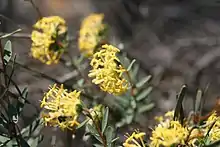Pimelea angustifolia
Pimelea angustifolia, commonly known as narrow-leaved pimelea,[2] is a small upright, slender or open shrub with whitish, cream, yellow or pink flowers. It is endemic to Western Australia.
| Narrow-leaved pimelea | |
|---|---|
 | |
| Pimelea angustifolia in Kalbarri National Park | |
| Scientific classification | |
| Kingdom: | Plantae |
| Clade: | Tracheophytes |
| Clade: | Angiosperms |
| Clade: | Eudicots |
| Clade: | Rosids |
| Order: | Malvales |
| Family: | Thymelaeaceae |
| Genus: | Pimelea |
| Species: | P. angustifolia |
| Binomial name | |
| Pimelea angustifolia | |
| Synonyms[1] | |
|
Synonyms
| |
Description
Pimelea angustifolia is a small shrub 0.1–1 m (4 in – 3 ft 3 in) high with smooth stems. The leaves are arranged in opposite pairs on a short petiole, mostly linear or narrowly elliptic, smooth, mid-green throughout, 2–30 mm (0.08–1.18 in) long and 1–5 mm (0.04–0.20 in) wide.[3]
Taxonomy and naming
Pimelea angustifolia was first formally described in 1810 by Robert Brown in his book Prodromus Florae Novae Hollandiae et Insulae Van Diemen.[4][5] The specific epithet (angustifolia) is from the Latin angustus meaning "narrow" and -folius meaning "-leaved".[6]
Distribution and habitat
Narrow-leaved pimelea is a widespread species, it grows from Kalbarri, in coastal areas to the South Australian border and inland north of Kalgoorlie mostly on sand, sandy clay, lateritic rock locations in sand dunes, plains, ridges and occasionally in wetter sites.[2]
Conservation status
It is not considered to be threatened at this time.[2]
References
- "Pimelea angustifolia". Australian Plant Census. Retrieved 21 January 2020.
- "Pimelea angustifolia". FloraBase. Western Australian Government Department of Biodiversity, Conservation and Attractions.
- Rye, Barbara L. (1990). George, Alex (ed.). Flora of Australia Volume 18 Podostemaceae to Combretaceae (PDF). Canberra: Australian Government Publishing Service. p. 183. ISBN 0644104724.
- "Pimelea angustifolia". APNI. Retrieved 21 January 2020.
- Brown, Robert (1810). Prodromus florae Novae Hollandiae et insulae Van-Diemen, exhibens characteres plantarum quas annis 1802-1805. London: Typis R. Taylor et socii. p. 360. Retrieved 21 January 2020.
- Francis Aubie Sharr (2019). Western Australian Plant Names and their Meanings. Kardinya, Western Australia: Four Gables Press. p. 133. ISBN 9780958034180.